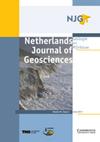Biostratigraphic ages and depositional environments of the upper Oligocene to lower Miocene Veldhoven Formation in the central Roer Valley Rift System (SE Netherlands-NE Belgium)
IF 2.3
2区 地球科学
Q3 GEOSCIENCES, MULTIDISCIPLINARY
Netherlands Journal of Geosciences-Geologie En Mijnbouw
Pub Date : 2022-03-07
DOI:10.1017/njg.2022.3
引用次数: 0
Abstract
Abstract Discussions on the age and the depositional environments of the Veldhoven Formation and its members are persistent in Belgium and the Netherlands. Uncertainties on stratigraphy and the constructive process of sediment accumulation continue today as a result of lack of data on this succession within the Roer Valley Rift System. The present study provides new information on the bio- and lithostratigraphy and facies from two boreholes based on dinoflagellate cyst taxa. The results were correlated by gamma-ray logs towards other key boreholes in the region and show a good consistency for stratigraphy and depositional environments for the members of the Veldhoven Formation. After marginal to restricted marine conditions in the latest Rupelian (early Oligocene), the start of deposition of the Veldhoven Formation marked the transition towards a higher sea level, expressed by increased glauconite contents and gamma-ray values. The Voort Member in the lower part of the Veldhoven Formation has an early to late Chattian (Late Oligocene) age and comprises predominantly shallow marine (fluctuating restricted to open marine) conditions. The lithology in the lower part of this unit is often very clayey but is coarsening upward into sands. The superjacent Wintelre Member has a latest Chattian to early Aquitanian (early Miocene) age. This member is distinct by its clayey nature which is expressed by relatively high gamma-ray values. Earlier studies suggest a deeper marine facies for the Wintelre Member compared to the Someren and Voort members. However, the dinoflagellate cyst assemblages in this unit are mostly dominated by a single genus indicating a restricted marine setting, including salinities that deviate from normal marine conditions, most probably due to minor ventilation by narrow or lack of connection to the Atlantic Ocean. A glacio-eustatic sea-level fall around the Oligocene/Miocene boundary limited the sea coverage to the strongest subsiding areas, where deposition of the Wintelre Member is recorded, while non-deposition or erosion occurred in the surrounding highs, hence creating an isolated (sub)basin. The superjacent Someren Member was deposited during the late Aquitanian to middle Burdigalian and consists of shallow to open marine clayey fine sands. Increasing clay contents indicate a gradual development towards a higher sea level, which coincide with upward increasing gamma-ray values. The biostratigraphic results of this study suggest that no major hiatuses are present in the differentially subsiding blocks of the Roer Valley Rift System during the late Oligocene to early Miocene.荷兰东南部-比利时东北部Roer谷裂谷系中部渐新统上至中新统下Veldhoven组生物地层时代与沉积环境
在比利时和荷兰,关于Veldhoven组及其成员的年龄和沉积环境的讨论一直持续。由于缺乏关于罗尔谷裂谷系统内这种演代的资料,地层学的不确定性和沉积物积累的建设性过程至今仍在继续。本研究提供了基于鞭毛藻囊群的两个钻孔生物和岩石地层及相的新信息。伽马测井结果与该地区其他关键钻孔进行了对比,表明Veldhoven组地层和沉积环境具有良好的一致性。在鲁佩尔晚期(早渐新世)的边缘到有限的海洋条件之后,Veldhoven组沉积的开始标志着向更高海平面的过渡,表现为海绿石含量和伽马射线值的增加。Veldhoven组下部的Voort段为早至晚夏世(晚渐新世)时代,主要为浅海(波动仅限于开阔海)条件。该单元下部的岩性通常为粘土质,但向上粗化为砂质。上覆的Wintelre段为Chattian - early Aquitanian(早中新世)时代。这个成员的独特之处在于它的粘土性质,这是由相对较高的伽马射线值表示的。早期的研究表明,与Someren和Voort组相比,Wintelre组的海相更深。然而,该单元的鞭毛藻囊群大多由单一属主导,表明受限制的海洋环境,包括偏离正常海洋环境的盐度,很可能是由于与大西洋的连接狭窄或缺乏通风而导致的。渐新世/中新世边界附近的冰川-上升海平面下降将海洋覆盖范围限制在最强的沉降区域,在那里记录了Wintelre段的沉积,而周围的高地没有发生沉积或侵蚀,因此形成了一个孤立的(次)盆地。上覆的萨默门段沉积于阿基坦期晚期至布尔迪加里亚期中期,由浅层至开阔海相粘土细砂组成。粘土含量的增加表明海平面逐渐升高,这与伽马射线值的上升一致。本研究的生物地层学结果表明,在渐新世晚期至中新世早期,罗尔谷裂谷系的差异沉降块体中没有出现大的断裂。
本文章由计算机程序翻译,如有差异,请以英文原文为准。
求助全文
约1分钟内获得全文
求助全文
来源期刊
CiteScore
4.00
自引率
25.90%
发文量
14
审稿时长
>12 weeks
期刊介绍:
Netherlands Journal of Geosciences - Geologie en Mijnbouw is a fully open access journal which publishes papers on all aspects of geoscience, providing they are of international interest and quality. As the official publication of the ''Netherlands Journal of Geosciences'' Foundation the journal publishes new and significant research in geosciences with a regional focus on the Netherlands, the North Sea region and relevant adjacent areas. A wide range of topics within the geosciences are covered in the journal, including "geology, physical geography, geophyics, (geo-)archeology, paleontology, hydro(geo)logy, hydrocarbon exploration, modelling and visualisation."
The journal is a continuation of Geologie and Mijnbouw (published by the Royal Geological and Mining Society of the Netherlands, KNGMG) and Mededelingen Nederlands Instituut voor Toegepaste Geowetenschappen (published by TNO Geological Survey of the Netherlands). The journal is published in full colour.

 求助内容:
求助内容: 应助结果提醒方式:
应助结果提醒方式:


